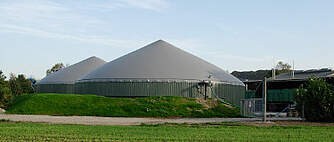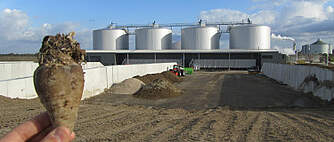Biogas upgrading to biomethane
One way to further develop biogas plants and exploit their sustainable potential is to convert them to biomethane plants.
Biogas upgrading from biogas to biomethan / renewable natural gas (RNG)
Biogas upgrading removes carbon dioxide, trace gases and impurities from the raw gas (biogas) to produce biomethane (also known as RNG - Renewable Natural Gas) as purified methane gas that meets the quality standards for natural gas. It typically contains over 96% methane and can be used as a natural gas substitute. Biomethane can be injected into the existing natural gas grid and used as a natural gas substitute for all end-use applications such as cooking, heating and cooling, power generation, transport, etc. The use of biomethane for the transport sector is either as CNG (Compressed Natural Gas) / (Bio-CNG) for passenger cars or as more energy dense LPG (Liquified Natural Gas) / (Bio-LNG) for heavy duty transport.
- Biomethane is active climate protection because, unlike natural gas, it is climate-neutral
Use of the by-product CO2 through CO2 liquefaction
The focus of many biogas projects so far has been on the use of methane (see News) as the primary energy component. However, with the increasing use of biomethane from biogas, the carbon dioxide (CO2) emissions produced during biogas upgrading can also be used effectively.
The upgrading of biogas to biomethane produces a high-concentration CO2 stream that can be liquefied in a separate plant under pressure and cold, and which can be used in a variety of ways and further processed and marketed as biogenic CO2. For example, in the beverage industry, greenhouses, as dry ice, and other technical applications.
- The GHG reduction ratio (REDII) of methane increases through the use of CO2
Methanation from H2 to CH4 (Bio-SNG)
The CO2 from biogas plants can also be combined with hydrogen in a methanation process to produce an additional methane stream - synthetic natural gas, Bio -SNG. (SNG = synthetic natural gas)
The hydrogen obtained during electrolysis (power-to-gas) can be processed into methane with CO2 using two different processes.
Firstly, biological methanation / microbial methanation, also known as methanogenesis. For this, highly specialised microorganisms are used that can convert hydrogen and carbon into pure synthetic methane or SNG at ambient pressure and temperature.
Secondly, catalytic methanation, a high-pressure gasification process in which methane or SNG is produced under high pressures and temperatures.
- With methane, the existing infrastructure and application can be used




